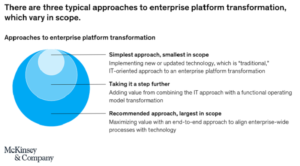At the end of last year, seven of the most valuable companies by market cap were platform based business. These companies reaped the advantages of ‘ecosystem network multiplier effect’catalysed by platforms. In India too, organisations like Reliance and Tata are in the process of creating platforms.

While the impression gained is that of needing huge scale for success as a platform-led enterprise, the real take aways we need to focus on are:
- The fast growth enabled with limited capital by being platform-led in your business approach
- The hidden fast growth experienced by participating in platform-led businesses of others
- The productivity and bottom-line growth possible by creating a platform based model inside your organisation itself.
For more information also read – https://smeventure.com/sidbi-initiatives-for-msmes-2022/
To illustrate the second point, notice the success of games and content developers who have leveraged the Apple and Google platforms, or the D2C success stories on Amazon/Flipkart platform, or even the individual cab drivers becoming entrepreneur of sorts, with their single or multiple cabs participating in Uber/Ola platform.
In a platform business model, instead of depending only on the native products the focus is on creating an ecosystem that enables multiple interactions between the numerous supply and demand points. The exponential value created here does not require much additional capital or physical inventory.
EY has identified 7 platform business models that are being leveraged globally:
- Symbiotic model – created by the likes of SAP, Microsoft, Tally etc.
- Marketplace model– Flipkart, Ola, Apple etc.
- Scaling model– Airline alliances
- Accretive model– GE and Six Sigma ecosystem
- Co-opetive model– Sony imaging system in multiple mobile brands
- Value chain model– Movement of shipping containers
- Integrator model– MakeMyTrip etc. taking responsibility for all aspects of a travel
All organisations, even the smallest ones have the opportunity to participate in these platform models as-long-as they are awake to the opportunity and ensure that their technology infrastructure is capable enough for easy integration. For example, a D2C player on Flipkart/ Amazon at the smallest level needs a computer, printer, and internet connection as infrastructure to participate. As the business grows this infrastructure needs to be enhanced with the addition of accounting, inventory, and backup systems, and the journey goes on.
Do watch – https://www.youtube.com/watch?v=hAbsk25QiNg
Businesses can also embed Platform Best Practices in their existing operations to move towards owning their own platform for others to participate. Greg Barasia, CFA, a seasoned finance professional with experience at major investment firms such as Lazard recommends the following Best Practices:
1:Think “Asset Light”
2: Increase commission-based revenue, lowering reliance on inventory turnover
3: Encourage third-party value producers to incentivize customers to join the network
4: Leverage increased consumer demand to encourage more producer participation
5: Identify value to third parties within your ecosystem to create a new revenue stream
Internal Enterprise Platform Transformation
According to McKinsey “An enterprise platform transformation of SG&A functions offers a unique opportunity to holistically optimize business processes in a way that will maximize the potential of a company’s technology, improve ROI, and clarify the business requirements for new platforms and IT stacks.” Organisations should consider enabling internal services to be delivered in an automated self-service format thus creating ecosystem advantages for the whole business and its employees/trusted partners.

The Indian JAM
The Indian stack of JAM (Jan Dhan, Aadhar, Mobile) is one of the biggest enablers of easy entry in to creation of platform-led business. Indian entrepreneurs’ have the best opportunity to create scale and partnerships that can be the launch pad for global foray. Organisations like Swiggy, Paytm, Ola were the early adopters and have grown accordingly. Others like Razorpay or Delhivery are now becoming large. There are now countless other businesses that will be known names in the next couple of years with their focus on platform and the advantage provided by JAM.
Importantly the success of all platforms internal or external, and their players, owner or participant, rests on their tech foundation. The underlying architecture needs to be flexible, open, scalable, and resilient enough to adapt to different ecosystem players and client needs. Tech and process scalability to manage growth and service the peaks, along with business continuity needs to be invested infor success and trust. The technology layer also needs to be flexible enough to manage platform dynamics and disruptors. Fortunately, all these elements are easily manageable at reasonable costs in today’s tech environment with the right partner.

Author: Arun Meena, Founder& CEO, RHA Technologies
